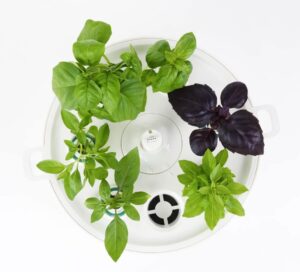Plantui Smart Garden 3
The Plantui Smart Garden 3 is the perfect indoor garden for small spaces. Supports herbs, salads, edible flowers, and chilies and tomatoes.
Blog
Plants can reproduce either vegetatively (asexually) or from seed (sexually). When reproducing vegetatively, the plant makes clones of itself. When you plant cuttings taken from plants, that’s making clones!
Strawberry reproduces very efficiently from runners, that grow around the plant. Each runner has exactly the same genome as the parent plant. That’s why they usually flourish at their growing place if the parent plant grows well there. Strawberry, however, also produces seeds. The plants grown from seed are the result of pollination and fertilization, so each of them have a new genome. That is beneficial if the growing conditions change, because then it’s important that the offspring is genetically diverse. Probably at least some of the new plants have genetic characteristics that help them to adapt to the new conditions.

Genetic diversity enables people to breed new plant varieties. First people didn’t do that on purpose: when people started to cultivate wild plants, the plant species changed little by little when they got used to the new conditions. That’s called domestication, and it resulted in local varieties that were well adapted to the local conditions.
People started to purposely interbreed cultivated plants in the late 1600s and early 1700s. Scientific plant breeding started in the early 1900s, as a result of the laws of inheritance discovered by an Austrian monk Gregor Mendel in the 1800s. Mendel created the basis of modern genetics by interbreeding pea plants.
The purpose of plant breeding is to produce plant varieties, that are accustomed to certain conditions, produce high and good quality yield and are pest resistant. A variety is a plant created by plant breeding, resulting in desirable characteristics. A new variety can also accidentally be found in the wild. One plant species can have thousands of varieties. The plants of the new variety should be as similar as possible, so that their characteristics will meet the variety description. So called F1-hybrid seeds are always very uniform, because they are produced via hybridization.
Usually we think that people have created the cultivated plants by actively choosing the best wild plants. But we can also observe the relationship between people and cultivated plants from the plant’s point of view, as Michael Pollan describes in his book The Botany of Desire. A Plant’s-Eye View of the World.
Breeding plants for human consumption can be considered evolutionarily so, that the plants have developed characteristics that are beneficial to people, like good taste or high level of carbohydrates. People have taken these plants for cultivation and so the plant species has harnessed this creative primate to clear forests to make fields, move the plants to this suitable area, get rid of pests and weeds and even collect and store the plants’ seeds to be sown during the next season.
Usually wild plants use a lot of resources to repel pests, compete with other plants for resources, and reproduction. From a plant’s-eye view, a high-yielding cabbage patch or a wide field full of wheat is a strategically genius triumph of one plant species against competitors and pests. Those plants simply use people as workforce and offer edible plant parts as a reward.
Are you interested in starting your own indoor garden? Plantui is the perfect product for you if you want to grow food inside with perfect quality and zero hassle. Choose from our two sizes.
The Plantui Smart Garden 3 is the perfect indoor garden for small spaces. Supports herbs, salads, edible flowers, and chilies and tomatoes.
Plantui Smart Garden 6 is the perfect indoor garden for homes with more space. Supports our whole plant selection, including microgreens.